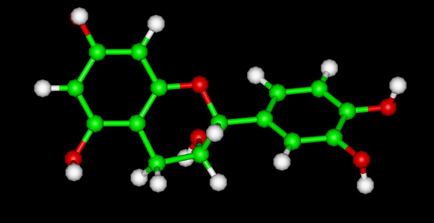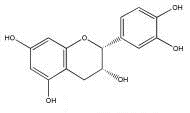 |
Phenols or polyphenols are natural chemicals found in most plant products. In general terms, phenolic compounds or polyphenols, have a similar basic structural chemistry including an “aromatic” or “phenolic” ring structure. They are most abundant or concentrated in fruit, wine, tea, coffee and chocolate. These substances have a bitter or astringent taste and are most noticeable when sugar is not present, as in dry red wine, baking (or cooking) chocolate, or tea. These compounds and have been associated with heart disease and cancer prevention.
Until now tea was thought to contain the largest amount of these antioxidants but research from: The Lancet “Antioxidants in Chocolate”, A.L. Waterhouse, J.R. Shirley, J.L. Donovan, Lancet, 348, 834 (1996), indicates that dark chocolate has four times as much as compared to tea. The researchers found that dark chocolate had 53.5 mg of catechins per 100 gm, milk chocolate contains 15.9 mg per 100 gm, and the black tea contains 13.9 mg per 100 ml. Chocolate like the red wine – which is said to protect against heart disease, also contains phenols. These reduce the presence of free radicals that damage cells and DNA. Phenols may also prevent fat like substances in the blood stream from oxidizing and clogging the arteries. Cranberry juice used for treating urinary tract infections contains the trimers (three-molecule aggregates) of epicatechin in the juice. It is may act act to inhibit the adhesion of bacteria to the cells that line the urinary tract.

Structure of Epicatechin
Recent Research in Epicatechin
From Nature: (2003) . Nature 424, 1013.
Serafini, M., Bugianesi, R., Maiani, G., Valtuena, S., De Santis, S. and Crozier, A.
Plasma antioxidants from chocolate
“Here we show that consumption of plain, dark chocolate results in an increase in both the total antioxidant capacity and the (-)epicatechin content of blood plasma, but that these effects are markedly reduced when the chocolate is consumed with milk or if milk is incorporated as milk chocolate.”
From: Crit Rev Food Sci Nutr. 2003;43(1):89-143.
Higdon JV, Frei B,
.Linus Pauling Institute,
Oregon State University, Corvallis, OR 97331, USA.
Tea catechins and polyphenols: health effects, metabolism, and antioxidant functions.
“Increasing interest in the health benefits of tea has led to the inclusion of tea extracts in dietary supplements and functional foods. However, epidemiologic evidence regarding the effects of tea consumption on cancer and cardiovascular disease risk is conflicting. While tea contains a number of bioactive chemicals, it is particularly rich in catechins, of which epigallocatechin gallate (EGCG) is the most abundant. Catechins and their derivatives are thought to contribute to the beneficial effects ascribed to tea. Tea catechins and polyphenols are effective scavengers of reactive oxygen species in vitro and may also function indirectly as antioxidants through their effects on transcription factors and enzyme activities. The fact that catechins are rapidly and extensively metabolized emphasizes the importance of demonstrating their antioxidant activity in vivo. In humans, modest transient increases in plasma antioxidant capacity have been demonstrated following the consumption of tea and green tea catechins. The effects of tea and green tea catechins on biomarkers of oxidative stress, especially oxidative DNA damage, appear very promising in animal models, but data on biomarkers of in vivo oxidative stress in humans are limited. Larger human studies examining the effects of tea and tea catechin intake on biomarkers of oxidative damage to lipids, proteins, and DNA are needed.”
http://www.worldofmolecules.com/antioxidants/epicatechin.htm







